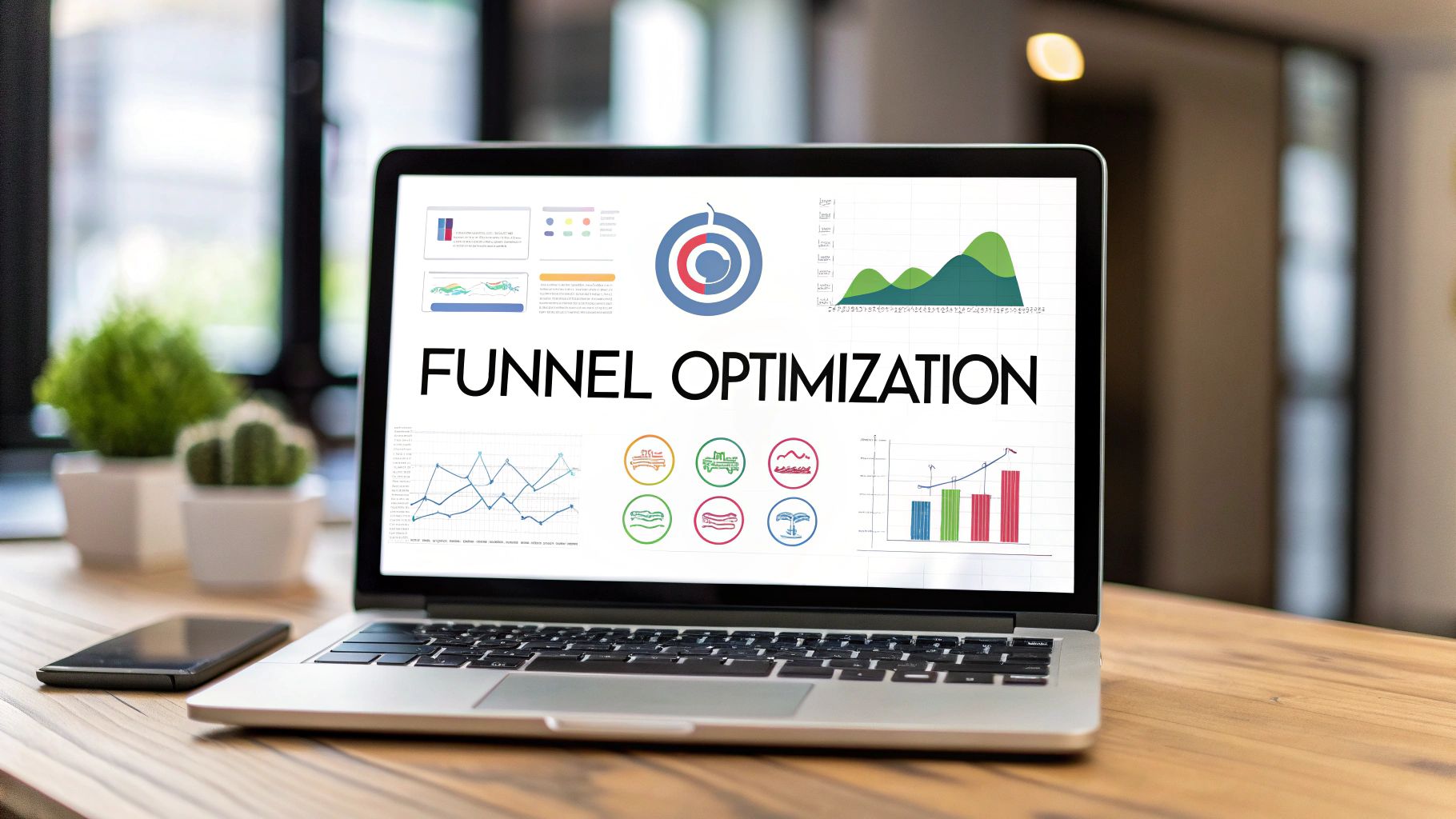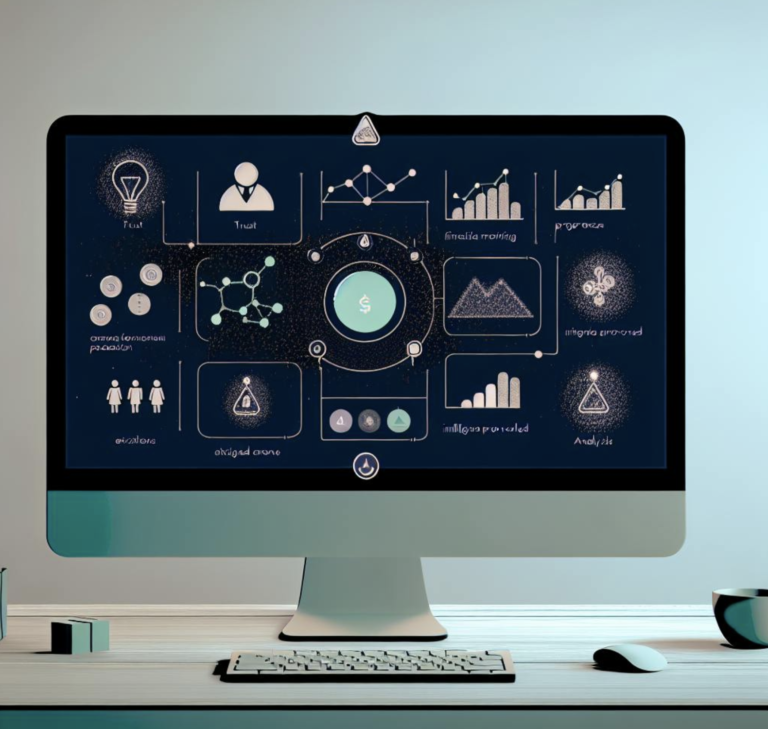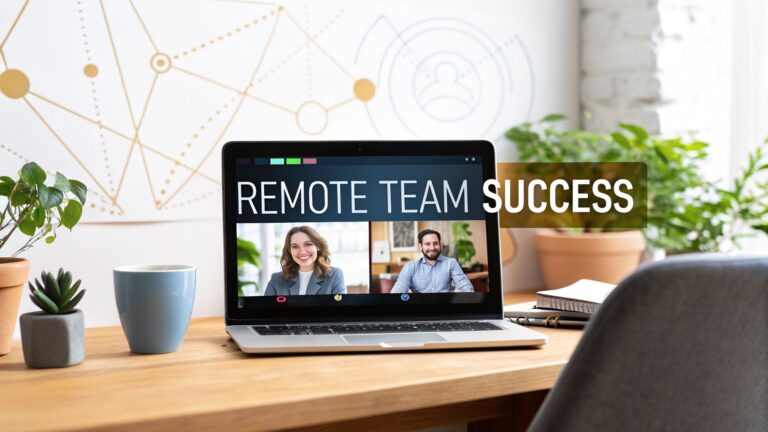10 Essential Sales Funnel Optimization Strategies for 2025
Your sales funnel isn't just a model; it's a critical system for converting interest into revenue. Yet, many businesses treat it like a leaky bucket, pouring valuable leads in at the top only to lose them through cracks of inefficiency, poor messaging, and a disconnected customer experience. This passive approach leaves significant money on the table. Actively managing and refining this system is the difference between stagnant growth and predictable, scalable success.
Effective sales funnel optimization strategies are about more than just patching holes. They involve a systematic process of identifying friction points, understanding user behavior, and implementing targeted improvements at every stage, from initial awareness to the final conversion. It’s about creating a seamless, compelling journey that guides prospects toward a purchase decision with precision and intent.
This article moves beyond generic advice and dives into ten actionable strategies you can implement immediately. We will explore specific tactics for everything from A/B testing your landing pages and refining email nurture sequences to leveraging social proof and implementing progressive profiling. You will learn not just what to do, but how to do it, turning your funnel from a passive pathway into an active, high-performance revenue machine.
1. Lead Magnet Optimization
Lead magnet optimization is a top-of-funnel strategy focused on refining the free, high-value resources you offer in exchange for a prospect's contact information. Instead of using a generic "contact us" form, you provide a tangible asset like an ebook, template, or tool. This approach transforms anonymous website visitors into identifiable leads by offering an immediate and compelling reason to engage. It's one of the most fundamental sales funnel optimization strategies because it directly boosts your lead capture rate, feeding the rest of your funnel with qualified prospects.
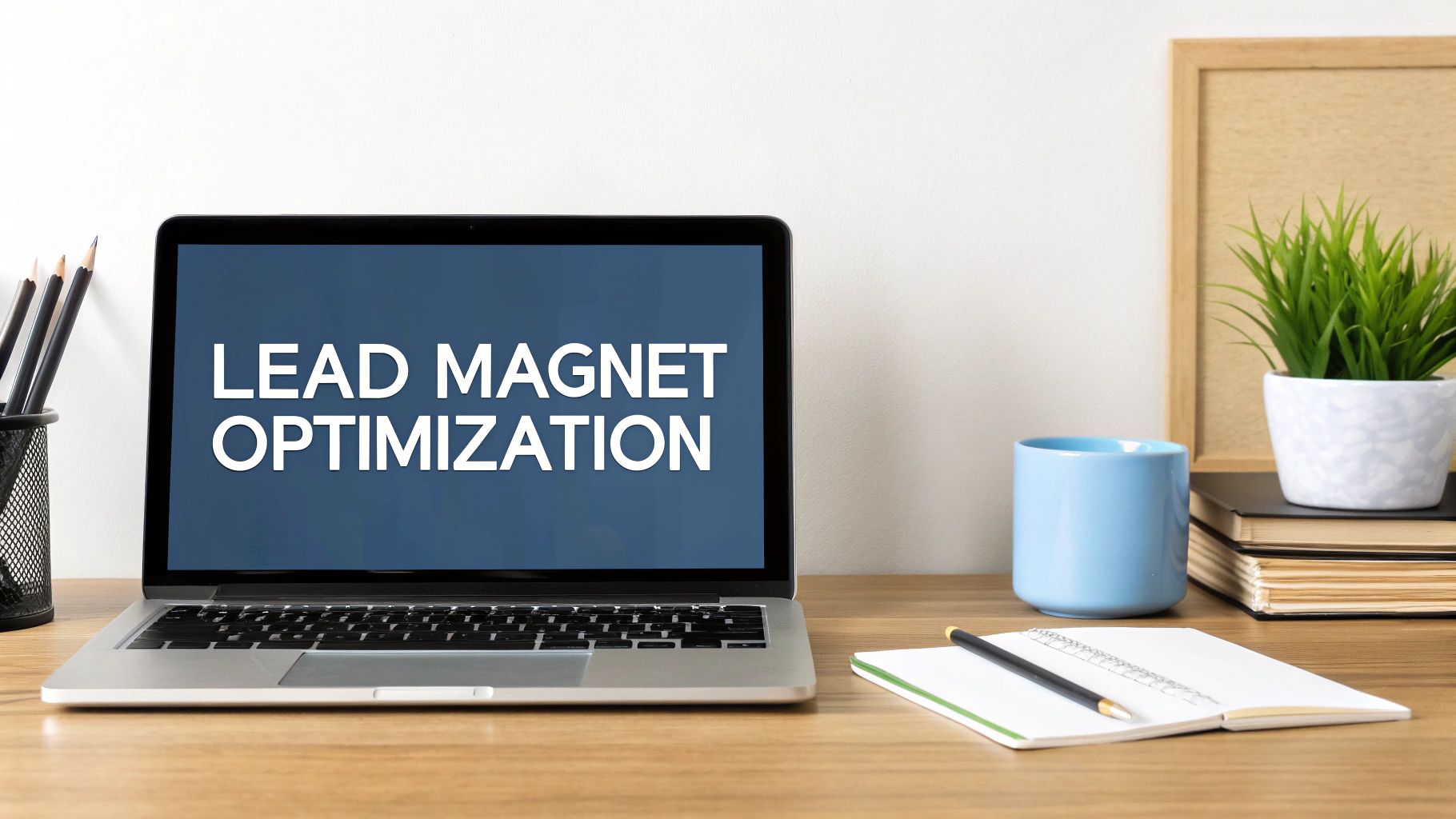
The key is creating an irresistible offer that solves a specific, urgent problem for your target audience. For instance, HubSpot offers a vast library of free marketing templates and tools, generating millions of leads who are prime candidates for their CRM software. Similarly, Neil Patel’s SEO analyzer tool provides instant value, capturing user data for future marketing efforts.
How to Implement This Strategy
To effectively optimize your lead magnets, focus on alignment, presentation, and follow-up.
- Align Magnet with Product: Ensure your free offer is a natural precursor to your paid solution. A checklist for "Choosing the Right Project Management Software" is a perfect lead magnet for a SaaS PM tool.
- Craft a Benefit-Driven Headline: Don't just name the asset; sell the outcome. Instead of "Social Media Ebook," use "The 5-Step Framework to Double Your Social Media Engagement in 30 Days."
- Minimize Form Friction: Only ask for essential information. Name and email are often enough. Every additional field you add can decrease your conversion rate.
- Automate Delivery and Nurturing: Use an automation tool to instantly deliver the asset via email and trigger a follow-up sequence. This immediate engagement is critical for moving leads further down the funnel. By tracking engagement with these assets, you can also begin to develop a robust lead scoring system. Find out more about the best practices for lead scoring.
2. A/B Split Testing
A/B split testing is a systematic, data-driven methodology for comparing two versions of a single variable to determine which performs better in achieving a specific goal. In the context of sales funnel optimization, it involves creating a variation (Version B) of a funnel element like a landing page, email headline, or call-to-action button, and testing it against the original (Version A). By showing each version to a segment of your audience, you can collect empirical data on which one drives higher conversions, eliminating guesswork from your optimization efforts.
This method is crucial for incremental and sustained growth. For example, during the 2012 presidential campaign, Barack Obama's team famously used A/B testing on their donation page buttons and media, ultimately increasing donations by 49%. Likewise, Electronic Arts leveraged split testing to increase game pre-orders by over 40% by testing different promotional offers. These examples highlight how small changes, when validated by data, can produce significant business impact.
How to Implement This Strategy
Effective A/B testing requires a structured process to ensure your results are reliable and actionable.
- Test One Element at a Time: To know what change caused a lift in conversions, isolate your variables. Test your headline or your button color, but not both simultaneously.
- Ensure Statistical Significance: Don’t end a test prematurely. Use a tool to confirm your results have reached statistical significance (typically 95% confidence) before declaring a winner.
- Prioritize High-Impact Tests: Start by testing elements that have the biggest potential impact on conversion, such as headlines, calls-to-action (CTAs), page layout, and offer presentation.
- Document Everything: Keep a detailed log of every test you run, including your hypothesis, the variations, the results, and your key learnings. This creates an invaluable internal knowledge base for future optimization.
3. Email Nurture Sequences
Email nurture sequences are automated email campaigns designed to build relationships, provide value, and guide prospects through the sales funnel over time. Instead of letting new leads go cold, this strategy delivers a pre-built series of targeted messages based on subscriber behavior or funnel stage. This is a critical mid-funnel optimization strategy because it systematically builds trust and educates leads, warming them up for a sales conversation or purchase decision without manual intervention.
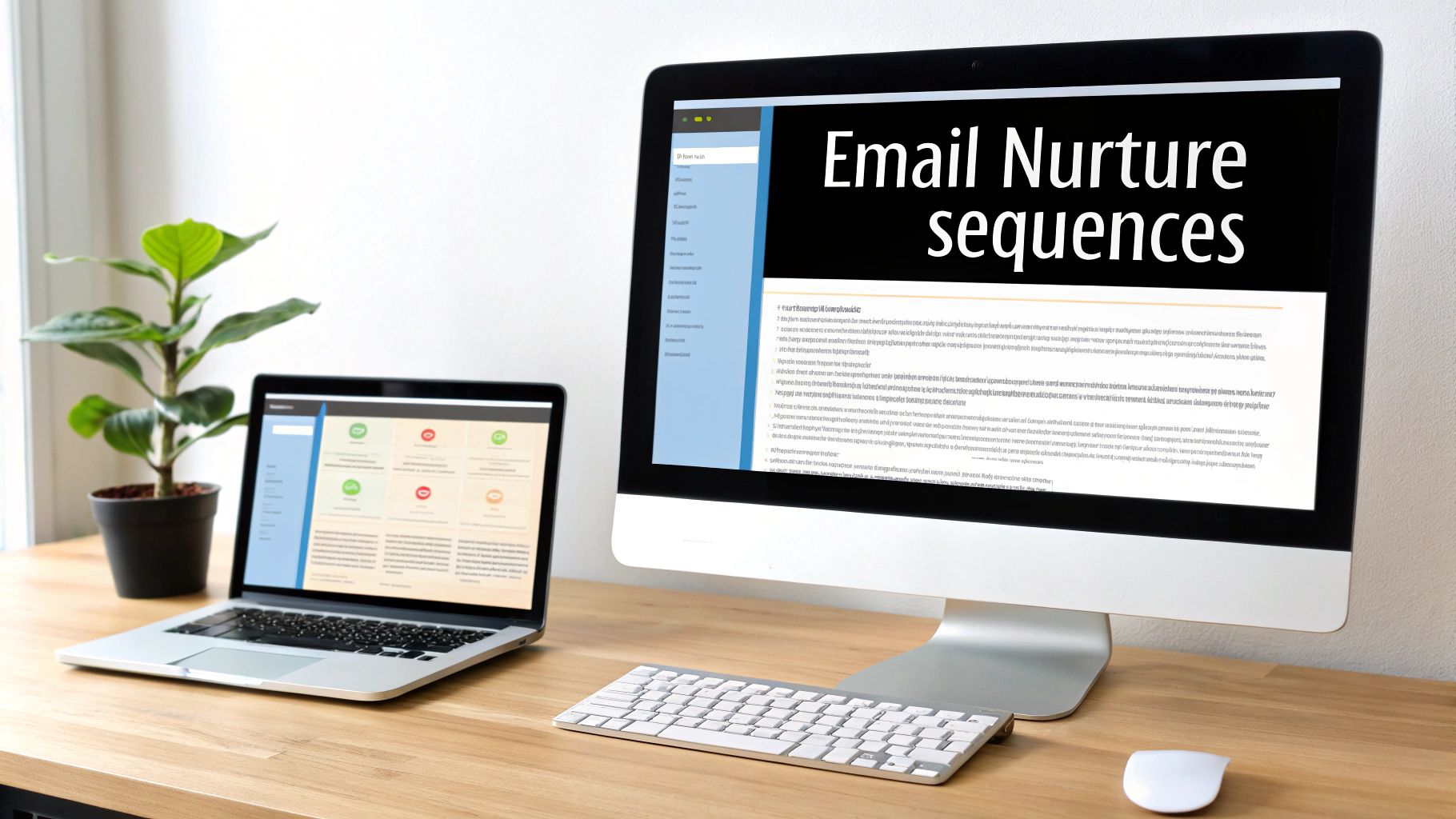
The goal is to maintain engagement and gently move prospects toward conversion by delivering the right message at the right time. For instance, DigitalMarketer uses sophisticated customer journey campaigns to guide users from initial awareness to purchase, generating millions in revenue. Similarly, Ramit Sethi's elaborate course launch sequences build immense anticipation and social proof, resulting in multi-million dollar launches by nurturing his audience over weeks.
How to Implement This Strategy
To create effective email nurture sequences, you must focus on timing, value, and personalization.
- Nurture Immediately After Opt-In: Trigger your welcome sequence the moment a lead subscribes. This is when engagement is highest, and it sets the tone for your relationship.
- Follow the 80/20 Value Rule: Dedicate 80% of your content to providing genuine value (education, tips, insights) and only 20% to direct promotion. This builds trust rather than just selling.
- Segment Sequences by Interest: Create different nurture paths based on how a lead entered your funnel (e.g., downloaded an ebook on Topic A vs. a webinar on Topic B). This personalization makes your content far more relevant.
- Use Storytelling and Clear CTAs: Weave a narrative across your emails to keep them engaging and human. Ensure every email has a single, clear call-to-action that guides the lead to the next logical step in their journey. To dive deeper, you can find out more about building automated email marketing campaigns.
4. Social Proof Integration
Social proof integration is a mid-to-bottom-funnel strategy focused on strategically placing evidence of customer satisfaction to build trust and credibility. This psychological trigger leverages the human tendency to follow the actions of others, reducing friction and purchase hesitation at critical decision points. By showcasing testimonials, reviews, case studies, and user counts, you provide third-party validation that your solution delivers on its promises. It's one of the most powerful sales funnel optimization strategies because it directly addresses a prospect's inherent skepticism, making them feel more confident in their decision to buy.
The key is to use authentic, specific proof that resonates with your target audience. For example, Slack prominently displays a "logo wall" of well-known enterprise clients on its homepage, instantly signaling its credibility to large organizations. Similarly, Amazon's extensive customer review system provides detailed, user-generated validation for nearly every product, a core driver of its conversion rates.
How to Implement This Strategy
To effectively integrate social proof, focus on specificity, placement, and authenticity.
- Be Specific and Authentic: Vague praise like "Great service!" is less impactful than a detailed testimonial. Use specific results: "This tool helped us increase lead conversions by 40% in Q2." Whenever possible, include the customer's full name, title, and company.
- Place Proof Near Conversion Points: Don't hide your best testimonials on a separate page. Place relevant social proof directly next to calls-to-action (CTAs), pricing tables, and sign-up forms to overcome last-minute objections.
- Use Diverse Formats: Mix up your social proof. Use written testimonials on landing pages, video case studies for high-value leads, and real-time user count notifications to create a sense of urgency and popularity.
- Systematize Collection: Don't wait for proof to come to you. Create an automated process to request reviews from customers after a positive interaction, such as a successful onboarding or a resolved support ticket. This ensures a steady flow of fresh, relevant content.
5. Retargeting and Remarketing
Retargeting and remarketing is a crucial middle-of-funnel strategy designed to re-engage visitors who left your website without converting. Using tracking technologies like pixels and cookies, this approach allows you to serve targeted ads to these prospects as they browse other sites and social media platforms. It's one of the most effective sales funnel optimization strategies because it acknowledges that over 97% of visitors don't convert on their first visit. By staying top-of-mind, you bring interested prospects back into the funnel to complete their journey.
This strategy is famously powerful for e-commerce, with Amazon’s retargeting efforts contributing significantly to its sales. In the B2B and SaaS world, companies like Perfect Audience use retargeting to help clients recover 15-25% more trial sign-ups by reminding prospects of the value they initially sought. The core principle is to reconnect with a warm audience that has already demonstrated interest, dramatically increasing conversion probability.
How to Implement This Strategy
Effective retargeting goes beyond simply showing the same ad to everyone. Success lies in segmentation, sequencing, and personalization.
- Segment Audiences by Intent: Group visitors based on their on-site behavior. Someone who visited a pricing page is a much hotter lead than someone who only read a blog post. Tailor your ad creative and offer to match their level of interest.
- Create Sequential Ad Campaigns: Don't show the same ad for weeks. Develop a narrative sequence that first reminds them of your brand, then highlights a specific benefit, and finally presents a compelling offer or case study.
- Exclude Recent Converters: To avoid ad fatigue and wasted spend, ensure your campaigns automatically exclude users who have already converted (e.g., signed up for a trial or made a purchase).
- Leverage Cross-Platform Consistency: Your message should be consistent across different platforms, from Facebook to Google's Display Network. To get the most out of your campaigns, you should review some best practices for cross-platform ad integration.
6. Landing Page Optimization
Landing page optimization is the systematic process of improving every element on a dedicated webpage to increase its conversion rate. This mid-funnel strategy focuses on refining headlines, copy, calls-to-action (CTAs), forms, and layout to persuade visitors to take a specific action, such as signing up for a demo or downloading a whitepaper. It’s a crucial component of any sales funnel optimization strategy because a high-traffic, low-converting landing page is a significant bottleneck that leaks potential revenue.
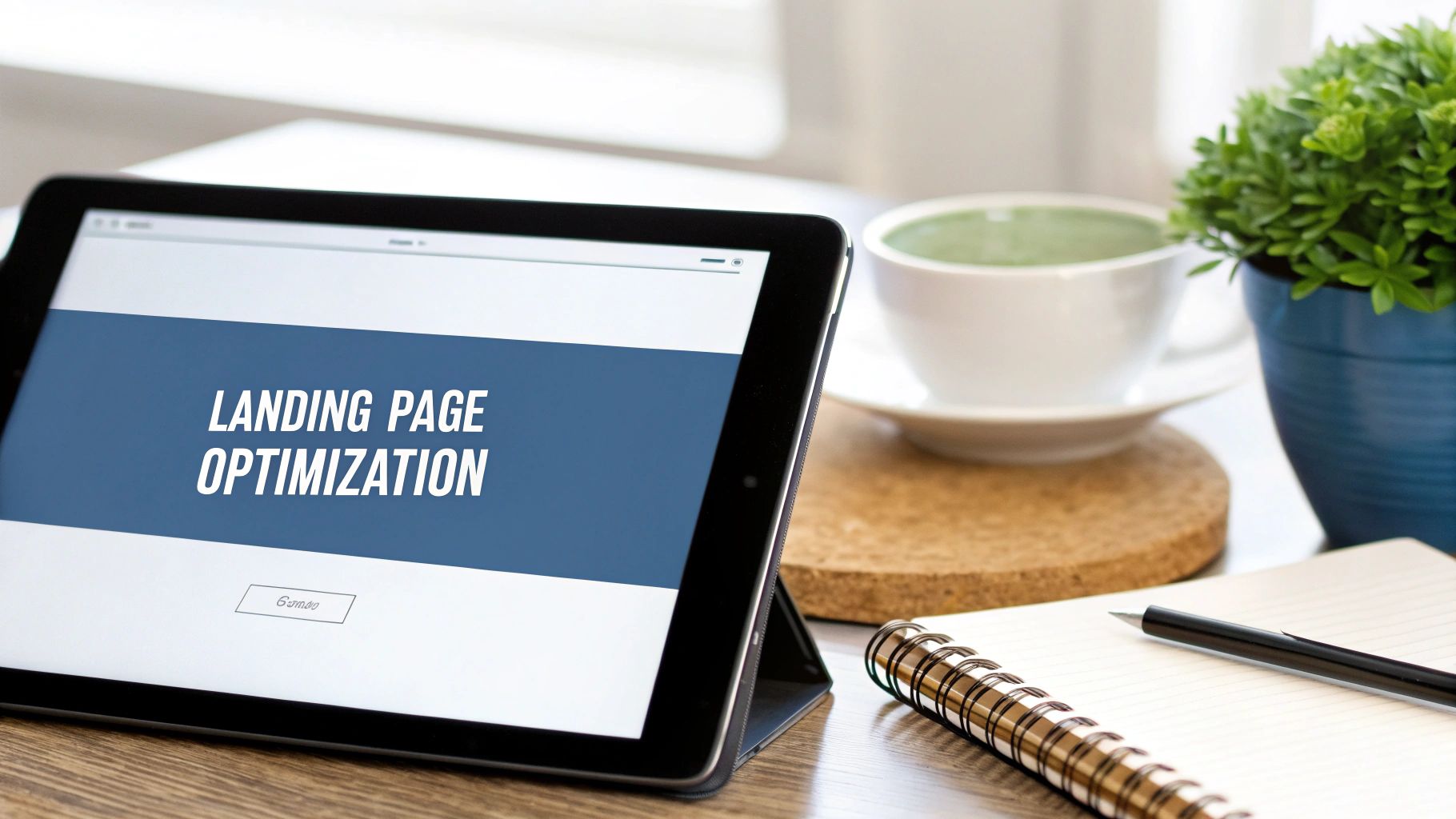
The goal is to create a frictionless experience that directly addresses the visitor's intent. Platforms like Unbounce and Leadpages have built their entire businesses around this concept, helping users achieve significantly higher conversion rates by focusing on dedicated, optimized pages. For instance, MarketingExperiments famously improved a client's conversions by 414% through iterative testing of page elements, proving the massive impact of targeted optimization.
How to Implement This Strategy
Effective landing page optimization requires a focus on message matching, clarity, and building trust.
- Match Message to Traffic Source: Ensure the headline and core message on your landing page directly reflect the ad or link the visitor clicked. A disconnect here is a primary cause of high bounce rates.
- Use Benefit-Focused Headlines: Your headline should immediately answer "What's in it for me?" for the visitor. Instead of "Our New CRM Software," use "Close More Deals in Half the Time with a Smarter CRM."
- Simplify Your Forms: Ask only for the information you absolutely need. Each additional field increases friction and can cause a drop in submissions. For a top-of-funnel offer, an email address may be sufficient.
- Include Trust Signals and Social Proof: Display customer logos, testimonials, case study snippets, or security badges. These elements reassure visitors and validate your claims, making them more comfortable with converting.
7. Progressive Profiling
Progressive profiling is a data collection strategy that gradually gathers information about prospects over multiple interactions instead of demanding it all at once. This approach minimizes initial friction by presenting short, simple forms, which encourages more sign-ups at the top of the funnel. As leads engage further, subsequent forms intelligently ask for new information, progressively building a detailed customer profile that enables powerful personalization and segmentation.
This method is a cornerstone of modern sales funnel optimization strategies because it balances the need for data with the user's desire for a seamless experience. For instance, HubSpot’s smart forms recognize returning visitors and swap out fields they've already completed for new ones. Similarly, Marketo and Pardot users often report significantly higher form conversion rates by asking for just a name and email upfront, then requesting details like company size or job title on a subsequent visit for a webinar or demo.
How to Implement This Strategy
Effective implementation requires a thoughtful approach to data collection that aligns with the customer journey.
- Start with the Essentials: Your initial form should only ask for the bare minimum, typically a name and email address. This low-commitment entry point maximizes top-of-funnel conversions.
- Map Your Data Needs: Identify which information is critical for qualification at each stage of the funnel. Ask for the company name on the second interaction and perhaps budget or timeline on the third.
- Use Smart Forms: Leverage marketing automation platforms that can recognize returning contacts and display new, relevant questions. This prevents you from asking for the same information twice.
- Provide Value at Each Step: Ensure that every request for more data is accompanied by a valuable offer. A prospect is more likely to share their job title for a highly relevant case study or an industry-specific report.
8. Multi-Channel Attribution
Multi-channel attribution is a middle-of-funnel analytics strategy focused on understanding the entire customer journey across all touchpoints. Instead of giving all the credit for a conversion to the last click, this approach assigns value to each channel that influenced the final decision. This provides a holistic view of how your marketing efforts work together, allowing you to optimize your budget allocation and invest in channels that truly drive conversions, not just those that assist. It's a critical component of modern sales funnel optimization strategies, as it prevents you from cutting budgets for top-of-funnel activities that are essential for building awareness.
This strategy moves beyond simplistic models to reveal the true ROI of your marketing mix. For example, B2B attribution platforms like Bizible (now part of Adobe Marketo Engage) help companies see how a blog post, a LinkedIn ad, and a sales call all contributed to closing a major enterprise deal. Similarly, Google's attribution modeling helps advertisers understand the complex path users take before making a purchase, justifying spend on seemingly low-converting awareness campaigns.
How to Implement This Strategy
To effectively implement multi-channel attribution, focus on data consistency, tool integration, and actionable analysis.
- Ensure Consistent UTM Parameter Usage: Create and enforce a strict, standardized system for using UTM parameters across all campaigns. This is the foundation for accurate tracking.
- Integrate Key Data Sources: Connect your CRM, marketing automation platform, and advertising accounts to a central attribution tool. This creates a single source of truth for the customer journey.
- Start with Simple Models: Don't jump straight to a complex data-driven model. Begin with linear or time-decay models to gather initial insights and build from there as your data maturity grows.
- Focus on Actionable Insights: The goal isn't perfect tracking; it's better decision-making. Look for clear trends, like which channels consistently assist in high-value deals, and adjust your strategy accordingly. Learn more about the different models and how to select the right one by exploring HubSpot's guide to attribution modeling.
9. Conversion Rate Optimization (CRO)
Conversion Rate Optimization (CRO) is the systematic process of increasing the percentage of website visitors who complete a desired action, such as signing up for a trial or making a purchase. Instead of guessing what might work, CRO relies on data analysis, user feedback, and structured testing (like A/B testing) to make informed improvements. This discipline is one of the most powerful sales funnel optimization strategies because it focuses on maximizing the value of the traffic you already have, directly improving ROI across all your marketing channels.
The goal is to understand user behavior, identify friction points, and implement changes that make it easier for prospects to move forward. Giants like Amazon have built their empire on obsessive CRO, constantly testing elements from button colors to checkout flows. Similarly, Booking.com's culture of continuous experimentation has been a key driver of its market dominance, proving that small, iterative changes can compound into massive revenue gains over time.
How to Implement This Strategy
Effective CRO is a continuous cycle of analysis, hypothesis, testing, and learning.
- Focus on High-Impact Pages: Start your optimization efforts on pages with high traffic but low conversion rates, such as your homepage, pricing page, or key landing pages. Small improvements here yield the biggest results.
- Use Qualitative and Quantitative Data: Combine analytics data (what users do) with qualitative tools like heatmaps, session recordings, and user surveys (why they do it). This provides a complete picture of user behavior.
- Test Boldly: Don't just test minor changes like button colors. Formulate hypotheses for radical redesigns of page layouts, value propositions, or offer structures. Sometimes, an incremental approach isn't enough to move the needle.
- Prioritize Mobile Optimization: With a significant portion of traffic coming from mobile devices, ensure your pages are not just responsive but fully optimized for a seamless mobile user experience. A clunky mobile checkout is a guaranteed conversion killer.
10. Customer Journey Mapping
Customer journey mapping is the process of creating a visual representation of every interaction a prospect has with your brand, from initial awareness to becoming a loyal customer. This holistic view allows you to step into your customer's shoes, pinpointing friction points, moments of delight, and opportunities for engagement. By understanding the entire experience, you can identify leaks and clogs in your sales funnel that analytics alone might miss, making it a crucial tool among sales funnel optimization strategies.
This infographic illustrates the foundational stages that form the backbone of a customer journey map, providing a framework to build upon.
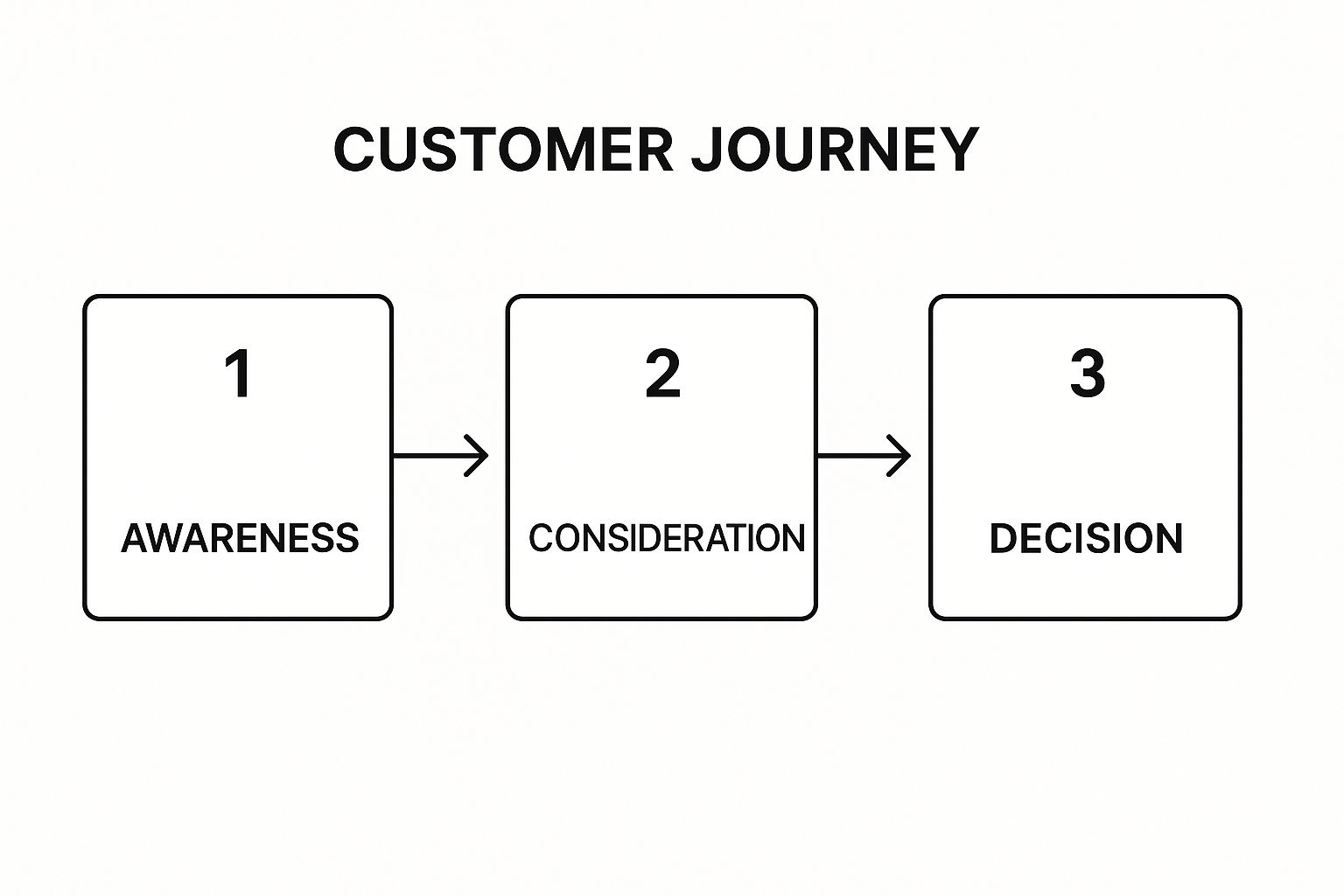
Mapping customer actions, thoughts, and emotions across these core stages helps you align your marketing and sales efforts with their actual needs. For example, Disney meticulously maps every touchpoint to create its "magical" experience, while Spotify optimizes the user journey from signup to playlist creation to boost long-term retention. These companies prove that a deep understanding of the customer path directly impacts business outcomes.
How to Implement This Strategy
To create an effective customer journey map, you must move beyond assumptions and ground your insights in real data and empathy.
- Map Different Segments: Don't create a one-size-fits-all map. Develop distinct journeys for each of your key customer personas, as their paths, motivations, and pain points will differ significantly.
- Use Real Customer Data: Base your map on qualitative and quantitative data from surveys, interviews, support tickets, and analytics. Assumptions lead to a fictional map that won't solve real problems.
- Include Emotional and Rational Elements: For each stage, document what the customer is doing, thinking, and feeling. This reveals the emotional drivers behind their purchasing decisions.
- Extend Beyond the Purchase: A complete journey map includes the post-purchase experience, such as onboarding, support, and advocacy. This is critical for improving customer retention and generating referrals.
Sales Funnel Optimization Strategies Comparison
| Strategy | Implementation Complexity | Resource Requirements | Expected Outcomes | Ideal Use Cases | Key Advantages |
|---|---|---|---|---|---|
| Lead Magnet Optimization | Medium – requires ongoing content creation and testing | Content creation, landing page design, automation | Higher lead capture rates (200-500% improvement) | Top-of-funnel lead generation | Cost-effective, audience segmentation, builds trust |
| A/B Split Testing | Medium to High – needs traffic and statistical knowledge | Testing tools, traffic volume, analytics | Measurable conversion improvements | Funnel element optimization and testing | Data-driven decisions, removes guesswork |
| Email Nurture Sequences | Medium – upfront content heavy, plus automation setup | Email marketing platform, content production | Builds trust, higher lifetime value | Relationship building and lead nurturing | Highly scalable, gradual conversion increase |
| Social Proof Integration | Low to Medium – content collection and display setup | Customer feedback, testimonials, social media | 15-34% conversion rate lift | Trust building across funnel stages | Reduces purchase anxiety, immediate credibility |
| Retargeting and Remarketing | Medium – requires tracking setup and ad management | Ad platforms, budget, audience data | 3-5x higher conversion than cold traffic | Re-engaging warm prospects | Higher conversions, reduces acquisition cost |
| Landing Page Optimization | Medium to High – technical skills and iterative design | Design tools, analytics, technical expertise | 2-5%+ conversion rate improvement | Paid traffic and campaign landing pages | Direct conversion impact, improved user experience |
| Progressive Profiling | High – complex setup and ongoing management | Marketing automation, CRM, dynamic forms | Increased conversion rates and better data | Reducing form friction and personalization | Builds comprehensive profiles, reduces abandonment |
| Multi-Channel Attribution | High – complex integration and compliance requirements | Advanced analytics tools, technical expertise | Optimized spend, full funnel insight | Marketing ROI and channel performance | Complete journey view, data-driven allocation |
| Conversion Rate Optimization (CRO) | Medium to High – ongoing process with data analysis | Analytics tools, user feedback, testing platforms | 20-30% conversion improvement in programs | Overall funnel performance enhancement | Maximizes traffic value, sustainable competitive edge |
| Customer Journey Mapping | Medium to High – research and design intensive | Cross-functional data, mapping tools | Reveals barriers, identifies opportunities | Customer experience and funnel analysis | Aligns teams, improves experiences and reduces costs |
Putting It All Together: From Strategies to Systems
We've explored ten powerful sales funnel optimization strategies, moving from attracting initial interest with optimized lead magnets to understanding the complete customer journey through multi-channel attribution. Each tactic, from A/B testing landing pages to implementing sophisticated email nurture sequences, represents a critical lever you can pull to enhance performance, reduce friction, and drive revenue.
However, the true power of these strategies isn't found in isolation. A high-converting landing page is less effective without a retargeting campaign to bring back lost leads. An insightful customer journey map is only actionable when you use its findings to refine your email sequences and social proof placement. The goal is to move beyond a collection of individual tactics and build an interconnected, intelligent system.
Your Path from Strategy to Sustainable Growth
Think of your sales funnel not as a static pathway, but as a living, dynamic ecosystem. Your role is to be the architect of that ecosystem, continuously observing, testing, and refining its components. The most successful B2B and SaaS companies treat funnel optimization as an ongoing process, not a one-time project.
The ultimate takeaway is this: optimization is a cycle of informed action. It begins with understanding your audience through journey mapping, forms a hypothesis, tests it with CRO and A/B testing, and measures the impact with clear attribution. This continuous loop is the engine of scalable growth.
Actionable Next Steps for Funnel Mastery
To translate this knowledge into immediate results, focus on these three priorities:
- Identify Your Biggest Leak: Start where the impact will be greatest. Use your analytics to find the single biggest drop-off point in your funnel. Is it the landing page conversion rate? The transition from email click to demo request? Focus your initial A/B testing and CRO efforts there.
- Map One Core Customer Journey: You don't need to map every possible user path at once. Select your most valuable customer segment and map their journey from their first touchpoint to their final conversion. This exercise will reveal invaluable insights and guide your optimization priorities for months to come.
- Automate One Nurture Sequence: Choose a key entry point, like a specific lead magnet download, and build a targeted 3-5 email nurture sequence. Use this as a testing ground for personalization, social proof, and progressive profiling to see how automation can improve engagement and qualification.
By implementing these sales funnel optimization strategies systematically, you transform your go-to-market approach from one of guesswork to one of precision engineering. You stop simply hoping for conversions and start building a predictable, scalable, and highly efficient engine for customer acquisition. The result is not just more leads or sales, but a foundational competitive advantage that is difficult for others to replicate.
Ready to turn these strategies into automated, seamless workflows? MakeAutomation provides the powerful, no-code platform you need to connect your apps and build the intelligent sales and marketing systems we've discussed. Start automating your lead nurturing, data enrichment, and customer onboarding today at MakeAutomation.

